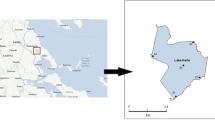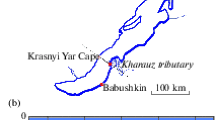Abstract
This study applied an atmospheric Computational Fluid Dynamics (CFD) model and a three-dimensional hydrodynamic-ecological lake model to investigate the impacts of variable wind forcing on lake hydrodynamics and water quality. The CFD model was used to predict the wind field over the lake surface which served as the meteorological forcing for the lake model. The study was carried out for the Marina Reservoir in downtown Singapore where field measurements of the wind field showed that temporal and spatial differences in wind field were found to be significant. By comparing simulations using uniform and spatially variable wind inputs in terms of thermal stratification, Richardson number, vorticity, and spatial gradients, this study demonstrates that the variability in wind forcing in urban lakes that arise from shielding and seasonal effects can have significant impacts on the hydrodynamics and water quality in the reservoir.








Similar content being viewed by others
References
Anderson J (1995) Computational fluid dynamics: the basics with applications. McGraw-Hill, New York
Ansys® (2011) Ansys fluent 13. Theory guide. Canonsburg, Pennsylvania, p 0
Antenucci J, Tan KM, Eikaas H, Imberger J (2013) The importance of transport processes and spatial gradients on in situ estimates of lake metabolism. Hydrobiologia 700(1):9–21
Bao C, Fang C (2012) Water resources flows related to urbanization in China: challenges and perspectives for water management and urban development. Water Resour Manag 26:531. https://doi.org/10.1007/s11269-011-9930-y
Bharat A, Ahmed S (2012) Effects of high rise building complex on the wind flow patterns on surrounding urban pockets. Int J Eng Res Dev 4(9):21–26
Du W, Xing Z, Li M, He B, Chua LHC, Miao H (2015) Sensor placement and measurement of wind for water quality studies in urban reservoirs. ACM Trans Sensor Netw 11(3):1–27
Fischer H (1979) Mixing in inland and coastal waters. Academic Press, New York
Fluent Inc. (2007) Gambit 2.4.6. user’s guide. Fluent Inc., Lebanon
Gilboa Y, Gal G, Friedler E (2014) Defining limits to multiple and simultaneous anthropogenic stressors in a lake ecosystem - lake Kinneret as a case study. Environ Model Softw 61:424–432
Google Earth (2018) Accessed 12 Feb 2018 https://www.google.com/earth/
Hipsey MR, Sivapalan M (2003) Parameterizing the effects of a wind shelter on evaporation from small water bodies. Water Resour Res 39(12):1339. https://doi.org/10.1029/2002WR001784
Hipsey M, Antenucci J and Hamilton D (2011) Computational aquatic ecosystem dynamics model: CAEDYM v3.2 science manual. Center for Water Research, University of Western Australia
Hodges B, Imberger J, Saggio A, Winters K (2000) Modeling basin-scale internal waves in a stratified lake. Limnol Oceanogr 45(7):1603–1620
Imberger J (2013) Environmental Fluid Dynamics. Elsevier. USA. pp 430
Lewis W (2000) Basis for the protection and management of tropical lakes. Lakes Reserv Res Manag 5:35–48
Lv J, Wu H, Chen M (2011) Effects of nitrogen and phosphorus on phytoplankton composition and biomass in 15 subtropical, urban shallow lakes in Wuhan, China. Limnologica 41:48–56
Markfort C, Perez A, Thill J, Jaster D, Porté-Agel F, Stefan G (2010) Wind sheltering of a lake by a tree canopy or bluff topography. Water Resour Res 46. https://doi.org/10.1029/2009WR007759
Misra K (2011) Impact of urbanization on the hydrology of Ganga Basin (India). Water Resour Manag 25:705. https://doi.org/10.1007/s11269-010-9722-9
Naselli-Flores L (2008) Urban lakes: ecosystems at risk, worthy of the best care. The 12th World Lake Conference 1333–1337
Podsetchine V, Schernewski G (1999) The influence of spatial wind inhomogeneity on flow patterns in a small lake. Water Res 33(15):3348–3356
Rubbert S, Köngeter J (2005) Measurements and three-dimensional simulations of flow in a shallow reservoir subject to small-scale wind field inhomogeneities induced by sheltering. Aquat Sci 67(1):104–121
Rueda F, Schladow S, Monismith S, Stacey M (2005) On the effects of topography on wind and the generation of currents in a large multi-basin lake. Hydrobiologia 532:139–151
Schlabing D, Frassl M, Eder M, Rinke K, Bardossy A (2014) Use of a weather generator for simulating climate change effects on ecosystems: a case study on Lake Constance. Environ Model Softw 61:326–338
Schueler T, Simpson J (2001) Why urban lakes are different. Watershed Protect Tech 3(4):747–750
Streetdirectory.com (2018) Accessed 12 Feb 2018 http://www.streetdirectory.com.sg/
Talling J, Lemoalle J (1998) Ecological dynamics of tropical inland waters. Cambridge University Press, Cambridge
Verhagen JHG (1994) Modeling phytoplankton patchiness under the influence of wind-driven currents in lakes. Limnol Oceanogr, 39(7):1551–1565. https://doi.org/10.4319/lo.1994.39.7.1551
Walker C, Lampard J, Roiko A, Tindale N, Wiegand A, Duncan P (2013) Community well-being as a critical component of urban lake ecosystem health. Urban Ecosyst 16:313–326
Xing Z, Fong D, Lo EY-M, Monismith S (2014a) Thermal structure and variability of a shallow tropical reservoir. Limnol Oceanogr 59(1):115–128
Xing Z, Liu C, Chua LHC, He B, Imberger J (2014b) Impacts of variable wind forcing in urban reservoirs. In: ISEH VII: 7th international symposium on environmental hydraulics 2014, Singapore, January 2014
Zeng Y (2010) A risk assessment on the alga bloom in city-a case of the “six seas” urban lakes in Beijing. Procedia Environ Sci 2:1501–1509
Acknowledgements
This work is supported by the Singapore National Research Foundation under its Environment & Water Technologies Strategic Research Programme and administered by the Environment & Water Industry Programme Office (EWI) and Public Utilities Board (PUB) of Singapore, under project 1002-IRIS-09.
Author information
Authors and Affiliations
Corresponding author
Additional information
Highlights
• Presence of tall buildings can significantly alter the wind field over the surface of urban lakes
• We utilise an atmospheric CFD model to predict the wind field over an urban lake
• A 3-D hydrodynamics and water quality model was used to study lake impacts
• Wind forcing was found to dominate the vertical and spatial mixing processes, more than other meteorological forcings
• Quantification of the thermal stratification, Richardson number, vorticity, and spatial gradients, show that wind shielding effects are significant
Rights and permissions
About this article
Cite this article
Xing, Z., Chua, L.H.C., Miao, H. et al. Wind Shielding Impacts on Water Quality in an Urban Reservoir. Water Resour Manage 32, 3549–3561 (2018). https://doi.org/10.1007/s11269-018-1980-y
Received:
Accepted:
Published:
Issue Date:
DOI: https://doi.org/10.1007/s11269-018-1980-y




